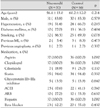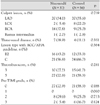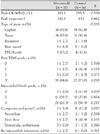Abstract
Background and Objectives
Intravenous nicorandil infusion with percutaneous coronary intervention (PCI) has been reported to reduce reperfusion injury events and to improve cardiac function in patients with an acute myocardial infarction. However, there is limited information on the use of intra-coronary nicorandil. A prospective randomized single center study was designed to evaluate the efficacy of the use of intra-coronary nicorandil.
Subjects and Methods
Seventy-three patients with an acute ST segment elevation myocardial infarction were randomly assigned to the nicorandil group (n=37) or a control group (n=36); all patients received a PCI. In the nicorandil group of patients, 4 mg of intra-coronary nicorandil was infused directly into the infarct area prior to reperfusion (2 mg before ballooning, 2 mg before stenting). The composite endpoint was the incidence of ventricular arrhythmia, no-reflow and slow flow. We estimated the post thrombolysis in myocardial infarction (TIMI) grade, the myocardial perfusion grade after PCI and the short-term clinical outcome.
Results
The baseline characteristics were similar in both groups of patients. A significant difference was observed in the composite endpoint in the nicorandil group of patients as compared to the control group of patients (p=0.037). The achievement rate of post TIMI grade 3 was significantly higher in the nicorandil group of patients (p=0.019). The myocardial perfusion grade 1 was not observed in the nicorandil group of patients; however, it was observed in five patients in the control group (p=0.019). Major adverse cardiac events in hospital and in 30 days were similar between the two groups.
Conclusion
Intra-coronary nicorandil infusion reduced the occurrence of no-reflow, slow reflow, reperfusion arrhythmia and improved the myocardial perfusion grade and TIMI flow during PCI. The results of this study showed that the use of intracoronary nicorandil improved the clinical outcome in patients with an acute myocardial infarction.
Figures and Tables
References
1. Ito H, Taniyama Y, Iwakura K, et al. Intravenous nicorandil can preserve microvascular integrity and myocardial viability in patients with reperfused anterior wall myocardial infarction. J Am Coll Cardiol. 1999. 33:654–660.
2. Ota S, Nishikawa H, Takeuchi M, et al. Impact of nicorandil to prevent reperfusion injury in patients with acute myocardial infarction. Circ J. 2006. 70:1099–1104.
3. Ikeda N, Yasu T, Kubo N, et al. Nicorandil versus isosorbide dinitrate as adjunctive treatment to direct balloon angioplasty in acute myocardial infarction. Heart. 2004. 90:181–185.
4. Kloner RA. Does reperfusion injury exist in humans? J Am Coll Cardiol. 1993. 21:537–545.
5. Reimer KA, Vander Heide RS, Richard VJ. Reperfusion in acute myocardial infarction: effect of timing and modulating factors in experimental models. Am J Cardiol. 1993. 72:13G–21G.
6. IONA Study Group. Effect of nicorandil on coronary events in patients with stable angina. Lancet. 2002. 359:1269–1275.
7. Lim SY, Bae EH, Jeong MH, et al. The clinical effect of intracoronary adenosine and nicorandil on no-reflow in acute myocardial infarction during percutaeous coronary intervention. Korean Circ J. 2004. 34:258–264.
8. Auchampach JA, Cavero I, Gross GJ. Nicorandil attenuates myocardial dysfunction associated with transient ischemia by opening ATP-dependent potassium channels. J Cardiovasc Pharmacol. 1992. 20:765–771.
9. Mizumura T, Nithipatikom K, Gross GJ. Effects of nicorandil and glyceryl trinitrate on infarct size, adenosine release, and neutrophil infiltration in the dog. Cardiovasc Res. 1995. 29:482–489.
10. Galie N, Guarnieri C, Ussia GP, et al. Limitation of myocardial infarct size by nicorandil after sustained ischemia in pigs. J Cardiovasc Pharmacol. 1995. 26:477–484.
11. Pieper GM, Gross GJ. Anti-free-radical and neutrophil-modulating properties of the nitrovasodilator, nicorandil. Cardiovasc Drugs Ther. 1992. 6:225–232.
12. Akai K, Wang Y, Sato K, et al. Vasodilatory effect of nicorandil on coronary arterial microvessels: its dependency on vessel size and the involvement of the ATP-sensitive potassium channels. J Cardiovasc Pharmacol. 1995. 26:541–547.
13. Brosh D, Assali AR, Mager A, et al. Effect of no-reflow during primary percutaneous coronary intervention for acute myocardial infarction on six-month mortality. Am J Cardiol. 2007. 99:442–445.
14. Claeys MJ, Bosmans J, Veenstra L, Jorens P, De RaedtH, Vrints CJ. Determinants and prognostic implications of persistent ST-segment elevation after primary angioplasty for acute myocardial infarction: importance of microvascular reperfusion injury on clinical outcome. Circulation. 1999. 99:1972–1977.
15. Aiello EA, Jabr RI, Cole WC. Arrhythmia and delayed recovery of cardiac action potential during reperfusion after ischemia: role of oxygen radical-induced no-reflow phenomenon. Circ Res. 1995. 77:153–162.
16. Ito H. No reflow phenomenon in coronary heart disease. J Cardiol. 2001. 37:Suppl 1. 39–42.
17. De Luca G, Suryapranata H, Stone GW, et al. Abciximab as adjunctive therapy to reperfusion in acute ST-segment elevation myocardial infarction: a meta-analysis of randomized trials. JAMA. 2005. 293:1759–1765.
18. Neumann FJ, Blasini R, Schmitt C, et al. Effect of glycoprotein IIb/IIIa receptor blockade on recovery of coronary flow and left ventricular function after the placement of coronary-artery stents in acute myocardial infarction. Circulation. 1998. 98:2695–2701.
19. Rim SJ, Hong GR, Im JW, et al. The cardioprotective effect of intravenous nicorandil for ischemia/reperfusion injury. Korean Circ J. 2005. 35:88–93.




 PDF
PDF ePub
ePub Citation
Citation Print
Print






 XML Download
XML Download